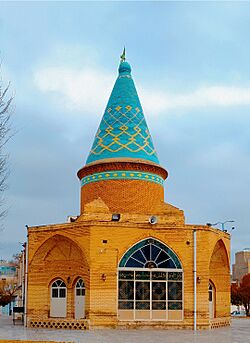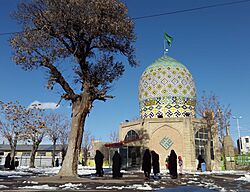Abhar facts for kids
Quick facts for kids
Abhar
Persian: ابهر
|
|
|---|---|
|
City
|
|
| Country | Iran |
| Province | Zanjan |
| County | Abhar |
| District | Central |
| Population
(2016)
|
|
| • Total | 99,285 |
| Time zone | UTC+3:30 (IRST) |
Abhar (Persian: ابهر) is an important city in Zanjan province, Iran. It is the main city of Abhar County and its Central District. Abhar has always been a key location because it sits right between the major cities of Qazvin and Zanjan.
Contents
What's in a Name?
The name "Abhar" comes from two words: āb meaning "water" and har meaning "mill". This name makes sense because there used to be many water mills in the area. Local people sometimes call the city "Awhar". Old books from the 10th and 13th centuries also used the name "Awhar".
Abhar Through Time
Abhar has been a very important place for a long time. It is located on a key route connecting different parts of Iran, including the central areas to the region of Azerbaijan.
Early History and Conquests
In 643 or 645 CE, Abhar was taken over during the Arab conquest of Iran. The people of Abhar fought bravely for several days. But in the end, they decided to make peace with the Arab forces.
Abhar was part of a region called Jibal, which later became known as Persian Iraq. In the 10th century, a writer named Ibn Hawqal said that the people of Abhar were Turkic.
Rulers and Dynasties
Many different rulers and empires controlled Abhar over the centuries:
- The Samanid ruler Ismail Samani captured Abhar between 892 and 907 CE.
- Later, in 916 or 917 CE, the Sajid governor Yusuf ibn Abi'l-Saj took Abhar from the Samanids.
- In 928 CE, an Alid ruler briefly took control, but he was soon pushed out by Asfar ibn Shiruya.
- In 930 CE, Mardavij took over Abhar from Asfar.
- The Samanid general Abu Ali Chaghani captured Abhar in 942 CE.
- In 997 CE, the Sallarid dynasty briefly seized Abhar from the Buyid ruler Majd al-Dawla.
- A coin found from 1013/14 CE shows that Abhar was an active place for trade.
- In 1029 CE, a Ghaznavid army led by Prince Mas'ud conquered Abhar.
Later Conflicts and Observations
In 1091 CE, the Nizari Ismailis took a fortress near Abhar. They held it until 1096 CE. In 1167 CE, Abhar was attacked by a commander from the Eldiguzid dynasty. He took women and children from the town. In 1217 CE, the Khwarazmshah Muhammad II conquered Abhar.
Abhar in the 14th Century
Hamdallah Mustawfi, who was a governor of Abhar in the 14th century, wrote a lot about the city. He said the city's walls were very long, about 5,500 paces. He praised the city's crops, especially its grains and many fruits. He mentioned special pears, plums, and black cherries. He also noted that the people of Abhar had fair skin and followed the Shafi'i school of Islam. The grave of a respected religious leader, Shaykh Abu Bakr, was also in Abhar.
Travelers' Accounts
- In the 17th century, a French traveler named Jean-Baptiste Tavernier visited Abhar. He wrote that it was a large, old city that was mostly in ruins. He also noted that some Armenians lived there.
- Another French traveler, Jean Chardin, visited Abhar in 1673. He said the town had faced many difficult times. Even though it had only about 2,500 houses, it had large gardens. He also mentioned that the people spoke Persian, which was different from earlier times when they spoke Turkic.
- In 1840, Comte Laurent de Sercey reported that Abhar had about 800-900 people and 200 houses.
- During the rule of Naser al-Din Shah Qajar (1848-1896), Abhar was an important base for the royal army.
People of Abhar
Language
Most people in Abhar speak Turkic languages. They also often speak Persian, so they are bilingual.
Population
The number of people living in Abhar has grown over the years:
- In 2006, the population was 70,836 people.
- In 2011, it increased to 87,396 people.
- By 2016, the population reached 99,285 people.
Uncovering the Past
The valley where Abhar is located has ancient remains and items from as far back as 2000 BC. This shows that Abhar has a very long history. Some old Islamic writers even connect Abhar to legendary figures from ancient Persian stories. For example, some say the city was founded by a Kayanian ruler named Dara II. Others credit Kay Khosrow with its founding. The writer Yaqut al-Hamawi believed that the Sasanian ruler Shapur II built Abhar and its fortress. It seems another fortress was built on top of this old one later on.
Important Historical Places
Abhar has several interesting historical sites you can visit:
- The tomb of Mawlana Qutb al-Din Ahmad al-Abhari, also known as Pir Ahmad. It is in the southern part of the city.
- The tomb of Imamzadeh Ismail, who was a descendant of Ali, an important figure in Shia Islam.
- The tomb of Prince Zayd al-Kabir, located in the eastern part of Abhar.
- The tomb of Imamzadeh Yahya, who is believed to be a descendant of Musa al-Kazim, the 7th Twelver Shia Imam.






